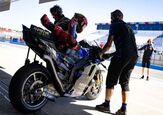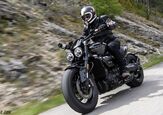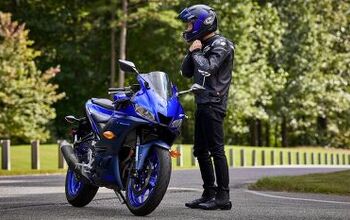Whatever! - Traction Control and What It Means for the Rest of Us
Every fall, the big magazine where I used to work hosts an industry ride up in the mountains outside Yosemite, a time for the ad sales people to get in some serious schmoozing, and an excellent time for the rest of us to get in some fantastic riding during the day and some open bar in the evenings.
Seven or eight years ago, I did the ride on a Honda XR650L, which I fell off of repeatedly. I’d get headed up a slightly gnarly hill, spin the back tire, get thrown out of shape a little, and oh dear, this bike is too tall for me, whump. There’s always an easy off-road loop laid out for wannabe off-road riders like me, a tough one for the hard-core dirt dudes, and a street loop – a mix of pavement and dirt roads – for guys who took Clint Eastwood’s advice and know their limitations. I am a pretty poor off-road rider, but I keep going back anyway. A glutton for punishment, my dad used to say. I took the easy loop on the XR, and still wound up with more than my share of lumps and bruises; so did the poor XR.
Two years ago, I rode up on a Suzuki V-Strom 650 Adventure. It was a great bike for getting there and seemed just the thing to ride on the street loop. Even so, I nearly wore it for a hat a couple times on some gravel roads when I got a little needy with the throttle through some bumpy sections. Ask Paul the Bohn body armor guy, who was following me, and felt it wise to take evasive action more than once. Street tires didn’t help, but I only blame my own ineptness; I know more than a few guys who could finish Paris-Dakar on the same V-Strom. Some of them were off on real dirt bikes up on Dusy-Ershim Trail. That link says it takes three days in a Jeep. Motorcycle guys do it in an afternoon. How I envy them, sigh …
Last year I rode up on an Indian Chief, and when I got there the only “dirt bike” available was a new BMW F800GS. I’d been to a Shane Watts school in the interim, had new Klim gear and was itching to try the easy off-road loop again. Corey Eastman is one of the guys who lays out the loops every year, and knows how “good” I am off-road.“Corey,” I asked, “can I make the easy loop on that BMW?”
“No, John. No you cannot.”
I accept the challenge.
Really, the easy loop is pretty easy about 90% of the time, but there are just a few tricky steep climbs that make it tough unless you have some skills. I got loose and sideways a couple of times in the first few miles of rutted, winding dirt road, looked down at the brand-new shiny $14,000 borrowed machine I was sat upon and nearly turned back. But I kept going because I hadn’t fallen off yet, and the more little hills I climbed and loose corners I roosted around without incident, the more my over-confidence grew. Even on street tires, the BMW seemed to have no trouble keeping right with people on XRs and Husqvarnas on knobbies. Wow, that Shane Watts is a genius. Even more genius, though, are the people at BMW who programmed the bike’s traction control.
I think what goes on, maybe, is I took to heart all that, “when in doubt, gas it” advice the good off-road guys always gave me; I was never quite sure if they were kidding. Maybe neither are they? I think it’s partially good advice, but maybe what I’d been doing wrong all these years is giving things too much gas on loose uphills when the going gets rough. Once the rear’s spinning, it throws you off course, pretty soon you’re running into rocks and roots you had wanted to steer around, pretty soon you’re off the trail and having to pick yourself up and get going again. Pretty soon you’ve got the weltschemrz, you’re tired as hell and swearing you’re going to get in better shape.
On the BMW, though, I just gave it gas and the computer – which you could hear cutting power but never really feel – would decide how much power was the right amount to maintain momentum without spinning the rear tire. Without the rear tire spinning, it was easy to steer the front one. Through boulders, alongside that deep rut instead of into it, around that log … say, this is fun. Being able to make it up a trail you never could’ve before does wonders for your confidence. Pretty soon you’re riding the motorcycle instead of it riding you.
Eventually we came to a clearing in the trees at the bottom of a longish, steep climb with loose rocky switchbacks and some pretty slick-looking slabs of bare granite, with a few boulders strategically placed to make things a little tougher and the ever-present deep rut criss-crossing the trail – the toughest section on the easy loop. I could see several cronies, way up at the top, taking a trail-side break and looking down at me. I gazed upon the lovely unbroken mirrors of my still-virginal BMW, its unbent handlebar and unmolested plastic, and I was afraid.
But there was no turning back now, was there? I let out the clutch and up she went in first gear, like a mountain goat. No problem. I was so happy I forgot for a second how short my legs are and almost toppled off the cliff at the top as I came to a stop. I wished I still smoked, it was a Marlboro moment. The air was way too clean up there. All that spoiled the perfection was that my friends were a little disappointed; they’d all stopped there to watch me destroy a $14,000 BMW. Sorry.
And now to my point: It saddens me when big magazines review bikes like this and say, ‘it works okay off-road after you switch off the traction control.’ Eh? The problem is, they always send the “experts” off to test bikes like this, and if you’re an expert, you grew up in the dirt and are used to riding like Taddy Husaberg or whatever his name is, spinning the rear all the time and jumping from mountain peak to mountain peak. You don’t really need traction control.
As if to prove my point as I sit here writing this, I see Cycle World just posted this about the new V-Strom 1000: “Despite the aforementioned off-idle glitch, which can be a bit disruptive when you’re trying to be gentle with the throttle, the engine is well suited to the dirt. With the traction control turned off, the V-twin delivers tractable, easy-to-modulate power everywhere. Its smooth, low-speed lugging ability is a plus, allowing a rider to maintain traction in slippery conditions where higher rpm or bigger throttle openings might cause a loss of rear-wheel grip.”
Well, gee, why not just leave the traction control switched on, and let it maintain traction in slippery conditions where higher rpm or bigger throttle openings might cause a loss of rear-wheel grip, since that’s exactly what it’s designed to do? I mean, this is the first production Suzuki with TC, so let’s explore how it works switched off? Seriously?
If it works half as good as what’s on the BMW F800GS, thousands of guys like me will be able to boldly go where they’ve never gone before. I have discussed TC and how it applies off-road with real experts, who have told me the problem is that when you come to a place where there isn’t any traction, you’ll have to turn around and get a run at the problem and use your expertness to get up the hill. Fine. I don’t want to go up Dusy-Ershim on a 500-pound dual-sport. I just wanna do the easy loop and get back to the bar with fingers that can still grasp a glass.
I learned the same thing a few years ago when we did a big comparison about liter-bikes with TC switched on and off. Our expert roadracer’s times never varied more than a second around Inde Motorsports Ranch, a really tight circuit with only one long straight. The main take-away from that test wound up being that TC is no big deal if you’re an expert. My times were way slower than his, but when I jumped from a ZX-6R (no TC) onto a new ZX-10R with TC, after a few laps in which I learned to trust the computer, I was circulating a full 10 seconds faster. That’s a ridiculous improvement.
Not only does good TC allow average riders to do things they normally can’t, it’s also a brilliant real-time teaching tool: Once you trust it, you’ll find out just how hard a thing like a ZX-10R can accelerate off a corner. Just twist the throttle till you see the pretty blinking lights on the dashboard. You’d be amazed how much more traction that rear contact patch actually has if you’d just been trusting your instincts all these years like me to make a rough estimate. And once you learn that feeling, you go faster on any bike, TC or not. Just like I learned that the rear street tire on the F800 is really not as much of an impediment to climbing a steep hill as my lack of a more sensitive throttle paw.
You begin to understand why the “experts” poopoo, downplay and or switch off the TC; it lets the rest of us ride more like them. But I think they’re doing a great disservice to the millions of us who are not, in the words of the great Tim Carrithers, “wing-footed deities.” As for me, I think TC is the greatest moto invention since the rubber tire.






































Comments
Join the conversation
I have friends who test bikes with me that are the same pooh pooh attitude, like there is no way the computer is better than them at figuring out traction. I'm with you, though, I can use all the help I can get.
Great stuff. Back in the old days we had traction control, it was caused by heavy crankshafts and low power output. Then egos got involved, cranks got lighter and power went up. It seems like TC lets us have the best of both worlds, pretty cool.
Remember Blazing Saddles:
Cleavon Little "Need any help?"
Gene Wilder "Oh, ... all I can get"
I'm with Gene and the bitter little man.